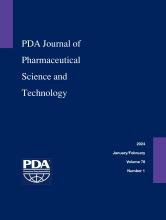Abstract
An important step in the development of a pharmaceutical drug product is to demonstrate acceptable levels of leachable impurities during the shelf-life and therapeutic use of the drug product. If the diffusion and partition coefficients are known, the concentration profile of a leachable impurity in the drug product can be predicted theoretically at a given temperature and time. With this objective in mind, kinetic experiments were performed to study the migration of low- to high-molecular-weight organic compounds from mono- and multilayer polyolefin films. Migration curves at different temperatures were generated for each compound when these films were brought in contact with aqueous solutions with varying pH or with another plastic film made from a different polyolefin material. “Best fit” migration curves and the corresponding diffusion and partition coefficients (about 300 pieces) were obtained by using numerical software developed by FABES. The results obtained show that, in general, the correlation between the calculated diffusion and partition coefficients and temperature, between 30°C and 85°C, obeys the Arrhenius and Van’t Hoff equations. In this temperature range, the diffusion and partition coefficients can be used to model and predict migration of the investigated compounds from the same pharmaceutical packaging materials. A comparison of these coefficient values with other polyolefin films also provides insights into the chemistry of the mono- and multilayers and the impact it has on the migration behavior of the compounds. In a consecutive paper, an approach to overestimate the diffusion and partition coefficients to account for the variability in experimental data is explained and finally, the use of these overestimated parameters to predict the concentrations for other compounds leaching from the multilayer films into aqueous drug product formulations is discussed.
- Extractables and leachables (E&L)
- Pharmaceutical packaging
- Diffusion and Partition coefficients
- Predictive modeling
- Migration modeling
- © PDA, Inc. 2024
PDA members receive access to all articles published in the current year and previous volume year. Institutional subscribers received access to all content. Log in below to receive access to this article if you are either of these.
If you are neither or you are a PDA member trying to access an article outside of your membership license, then you must purchase access to this article (below). If you do not have a username or password for JPST, you will be required to create an account prior to purchasing.
Full issue PDFs are for PDA members only.
Note to pda.org users
The PDA and PDA bookstore websites (www.pda.org and www.pda.org/bookstore) are separate websites from the PDA JPST website. When you first join PDA, your initial UserID and Password are sent to HighWirePress to create your PDA JPST account. Subsequent UserrID and Password changes required at the PDA websites will not pass on to PDA JPST and vice versa. If you forget your PDA JPST UserID and/or Password, you can request help to retrieve UserID and reset Password below.






